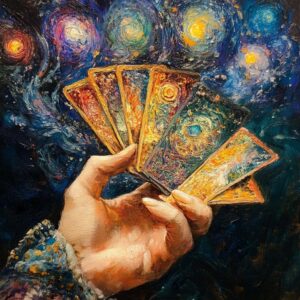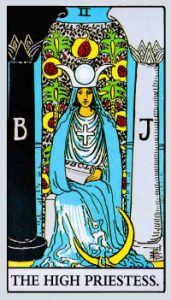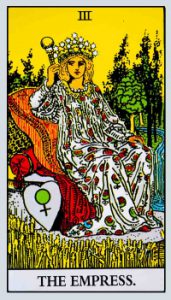
The mythological story of Demeter and Persephone is the one that stands behind the Empress and High Priestess Tarot cards. Demeter, who represents the Empress card, is the goddess of grain and fertility. She was the daughter of Cronus and Rhea, and the sister of Zeus (Jupiter in Roman mythology), Poseidon, Hades, Hera, and Hestia. She was one of the twelve Olympian gods.
 |
 |
The Empress card represents Demeter, while her daughter Persephone is represented in the High Priestess card.

Hades, the god of the underworld, fell in love with Persephone, Demeter's daughter, and abducted her to the underworld. Hades offered Persephone an abundance of food, but she only ate six pomegranate seeds. Demeter, who loved her daughter, was furious at her abduction and stopped the growth of crops and vegetation, bringing cold and winter to the earth. The humans, left without food, begged the gods to change the harsh decree. Zeus approached Demeter, and she agreed to restore order on the condition that Persephone would return to the surface. Zeus demanded that Hades return Persephone to her mother.
When Hades allowed Persephone to return to the surface, he demanded that she stay in his kingdom for one month for each seed she had eaten. During these months, Demeter's sorrow returned, and she froze the earth; the leaves would fall, and nothing would grow in the winter that ensued. This is how the Greeks explained the changing of the seasons.
When Persephone stayed with Hades, it was winter and autumn, and when she returned from the underworld, everything began to blossom and grow, spring arrived, followed by summer, and people enjoyed agricultural abundance.
Persephone (whose name means "Destroyer of Light") was the queen of the underworld and the wife of Hades, the god of the underworld. Persephone and Hades were one of the few divine couples who did not have children. Persephone was a beautiful maiden who spent her days on the earth and not on Olympus with the other gods. She would plant trees and pick flowers. One day, while she was walking in the forest, Hades made a white flower grow, the Datura plant, also known as the Devil's Trumpet. The flower greatly attracted her attention, and when she was about to pick it, the earth opened, Hades emerged, kidnapped her, and brought her to his kingdom beneath the earth.
The archetypes in the story: an innocent maiden, the lover who abducted her, and the grieving mother.
Is Persephone really a victim? Persephone's character is more complex than that of an innocent maiden abducted from the earth; she embodies duality. The innocent maiden is, in fact, for six months, the goddess of the underworld, a cold goddess ruling a great kingdom, and on the other hand, for six months, she is the goddess of spring, bringing light and joy.
In the world above, Persephone had no role; she was not a recognized figure, while in the world below, she was the goddess of the underworld, one of the strongest female figures in mythology. When she rises from the underworld after the abduction, she is welcomed as the goddess of spring, bringing blossoming and prosperity.
Persephone knew all the plants and understood which plants Hades used. She knew that she must not eat the fruit of the underworld, as whoever eats something in this realm must stay there. So the question arises, why did she eat the pomegranate seeds? The reason is that there was a part of her that wanted to; there was a part of her drawn to the underworld, to those dark, unknown, and unfamiliar aspects of personality. Without confronting those parts, without touching them, a person will not be whole. When everything is clear and the curtain is lifted from the mystery of life, everything seems simple.

Orit Raphael, Tarot Reader for Personal Guidance, Insights, and Messages